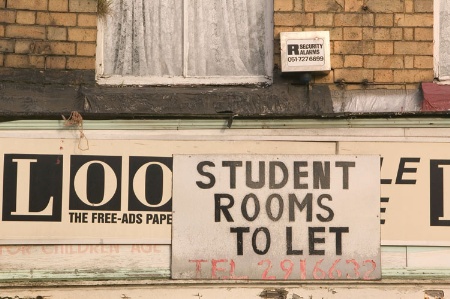Source: Getty
“Freshers’ Week, Halloween, St Patrick’s Day…it is mayhem.” But it is not just the occasional celebration that upsets Ray Farley, chairman of the residents’ association in Belfast’s Holylands, a square kilometre of terraced streets that is home to an estimated 10,000 students.
“When you have that many students in one area, it will be 30 students’ birthdays on any one day and, of course, they all want to have parties,” says Farley. “We have people shouting and screaming at night or playing Gaelic football in the road at 2am.”
Such town-gown tensions have been documented as far back as the 13th century, as a 2010 report from Universities UK, called Living Together, Working Together, points out. But the continuing expansion of the higher education system has brought the issue to particular prominence in recent years.
Student numbers have risen from about 1.5 million in the mid-1990s to 2.5 million today.
With an extra 30,000 undergraduates set to enrol in England this autumn and another 30,000 to follow in 2015 after student number controls were relaxed by Chancellor George Osborne last December, might some university towns feel “swamped” by students? While universities, students’ unions and community leaders have worked together for decades in an effort to bring about harmonious living, does more need to be done?
Cities such as Bristol, Edinburgh, Cardiff, Liverpool and Newcastle already have an “acute undersupply of accommodation”, according to estate agents Knight Frank in its 2014 Student Property report, which found that up to three-quarters of students in these towns lived in houses of multiple occupation.
The transformation of Belfast’s Holylands (its street names include Damascus, Palestine and Jerusalem) over the past 20 years from a relatively harmonious mix of students, young professionals and families to what some describe as a “student ghetto” – with about 90 per cent of housing occupied by students – has been dramatic. It is also typical of the “studentification” that has occurred in the areas neighbouring many UK universities.
St Patrick’s Day has been a particular flashpoint in recent years – albeit defused this year after Queen’s University Belfast scheduled an additional “reading day” the preceding Friday to encourage students to go home for a long weekend.
“But it has been terrible in the past – students are allowed to drink in their front yards, so if you have 10 students per house, you might have 400 students in a single street,” says Farley. Student partying has led to intervention by riot police, with 48 people arrested on St Patrick’s Day in total in the Holylands area between 2009 and 2012.

With the area costing local authorities about £3 million a year to police, clean and supervise, Farley feels that residents are bearing a high price for the student influx.
All this may sound a long way from the image of more serious, studious and sober £9,000-fee-paying students, yet as one university website puts it, it takes only “a minority of students…[behaving] irresponsibly” for problems to occur.
Queen’s, for its part, says that all complaints are investigated and action is taken to discipline students who have broken off-campus conduct regulations.
Other initiatives taken by the university to counter the friction include the creation of a neighbourhood forum that meets three times a year, educational campaigns aimed at students and a 24-hour helpline to handle residents’ complaints. In addition, 13,000 students were involved in voluntary work last year, including an award-winning homework club for local children, while £111,000 was raised by its “RAG” club for local causes.
Farley recognises that Queen’s – and the University of Ulster – has taken steps to minimise disruption to local residents. “The problem is that they start from scratch every year as a new set of students arrive,” he says.
Stories about town-gown tensions provide good copy for local newspaper editors, and Lincoln is one city in which the local press has been kept busy with articles about local residents who are dismayed at students’ behaviour.
The University of Lincoln began life as an offshoot of the Hull-based University of Humberside in 1996, but, by 2002, the university had moved to Lincoln wholesale and changed its name accordingly. It now has 13,000 students.
According to Ric Metcalfe, the leader of City of Lincoln Council, the consensus in the city is that the university’s arrival has had an “overwhelmingly net positive” effect. The benefits include its transformation of a large, inner-city brownfield site, the economic boost to the local service sector and the “excellent connections” the university has brought to the city with various employment sectors, such as pharmacy, arts and media and, perhaps most notably, engineering. The global giant Siemens employs 1,500 people at its gas turbine plant in the city and has co-located some of its research and development activity in Lincoln’s School of Engineering, which it also supports financially. These connections are “beginning to have a real stimulus effect in terms of boosting volume of skilled employment in Lincoln, which is what we badly need”, says Metcalfe.
Across the country, universities directly employ about 378,000 people – 1 per cent of all UK staff – and create another 373,800 full-time posts outside higher education, according to a Universities UK report, The Impact of Universities on the UK Economy, published in April. Without a university, businesses in many towns and cities would struggle, it adds. For example, Bangor University’s 11,000 students double the population of the North Wales town in term-time, with many livelihoods dependent on student trade.
Indeed, scarcely a month goes by without a new report hammering home the various advantages of having a vibrant university sector and strong student numbers. Recently, David Willetts, who was universities and science minister until he left his post amid last week’s Cabinet reshuffle, said that he hoped to see more university campuses developed in existing “cold spots” of higher education provision, such as East Anglia and Yeovil in Somerset.

But Lincoln council’s Metcalfe acknowledges that the students’ arrival has exacerbated pre-existing strains on the availability of private rented accommodation, which has driven up rents, and he is anxious that any further expansion in student numbers when the recruitment cap comes off is “done sustainably”.
Danny Dorling, professor of geography at the University of Oxford, believes that rent spikes may well become commonplace around universities that expand in the era of uncapped numbers – particularly since universities exposed to the whims of “fashion” may be loath to invest further in student housing.
Conversely, those universities that lose out in the scrap for students – particularly if they are in poor areas, where vacated student housing is not in great demand from locals – could see whole areas on their doorsteps become depopulated and even demolished.
The idea that “on a fairly crowded island, everything will work itself out through market mechanisms may be found wanting”, suggests Dorling, author of Inequality and the 1% (forthcoming). He also questions the extent to which poor, low-skilled local people living adjacent to some universities really benefit from their presence, since many of the support posts universities create are “not as widely advertised as they might be” in the area, and are typically monopolised by long-term residents, rather than newer immigrant communities.
Dorling fears that the universities that do well in the uncapped system are likely to be in areas that “don’t necessarily need more housing pressure or more jobs” – that is, towns and cities to which many already commute long distances owing to the high cost of housing.
One prime example of this is Cambridge. As well as the University of Cambridge and Anglia Ruskin University, the city also hosts a highly successful science park and biotech sector, which has driven the pressure on – and cost of – housing almost to London levels. Blue-chip firms anxious to be close to University of Cambridge research include Microsoft, whose European research base is now located close to the city’s railway station, and recent takeover target AstraZeneca, which, in 2016, will relocate its entire 2,000-employee R&D division from Cheshire – to the dismay of some concerned by the so-called North-South divide. It is not only growth in student numbers that can have a significant impact on local communities and populations: research-intensive universities can act as magnets for high-tech and high-skill employers. While this can bring money into an area, it can also change the dynamics of local job and housing markets and put pressure on infrastructure.
When the price of accommodation rises, universities themselves can feel the pain, says Dorling. If high-quality support staff can no longer afford to live in the area, universities may be forced to recruit commuters who may not stay long in the job. In Cambridge, there are concerns that the ongoing influx of tech entrepreneurs, London commuters and commercial scientists may price even senior academics out of the city. As Ross Anderson, professor of security engineering at Cambridge’s Computer Laboratory, puts it: “The typical Cambridge resident whom I meet socially has a computer science or engineering degree, just like us. The only real difference is that he earns more money.”

The University of Cambridge recently unveiled its enormously ambitious North West Cambridge project: a £1 billion scheme to construct an entire new district of the city, complete with housing, academic buildings and local amenities, aimed at fulfilling the university’s “long-term growth needs” and address a lack of affordable housing for staff and postgraduates. It anticipates that its student numbers will increase by 5,000 and staff numbers by 3,000 over the next 25 years. Meanwhile student numbers at Anglia Ruskin have grown by a third since 2006-07.
Allan Brigham, a local tour guide, retired road sweeper and member of Cambridge’s East Mill Road Action Group, says that developers have rushed to erect accommodation for the city’s two universities. In March, the Cambridge News reported that 4,501 student bedrooms have been built in Cambridge in the past eight years (and a further 2,335 have planning permission), compared with only 2,480 family homes.
On the concentration of students in some areas of the city, Brigham says that “young people and students bring a certain vibrancy to an area and support lots of the cafes and bars, but there is a tipping point”. He added: “If no one cares if bins go in and out, whether the roads fall into disrepair or how good the local school is, then a community starts to deteriorate.”
Across the UK, several cities, including Newcastle, Sheffield and Leeds, have already invoked powers known as Article 4 Directions to require landlords to seek permission to convert houses where three to six people reside, thereby allowing them to regulate student density in certain areas.
But councils have little control over student recruitment per se, and Dorling suggests that it “might be worth being a bit more careful” about what happens when the numbers cap is removed “because of the much wider implications” for local areas. He suggests that the cap could be removed gradually. And in areas that suffer a decline in student numbers, he puts forward the idea that a pot of money might be set aside to finance and thereby encourage part-time study.
Sir Peter Hall, Bartlett professor of urban regeneration and planning at University College London, thinks that some level of central planning of student numbers is desirable. And while he acknowledges the magnetic draw of the “golden triangle” of London, Oxford and Cambridge, he believes that the physical constraints on the expansion of research facilities in those cities strengthen the case for the redirection of more research funding to other universities further north.
On rising student numbers, he points out that growth need not necessarily impose greater demand on local housing if the new students are from local areas. One way to achieve expansion without “all the stresses and strains” that can be associated with it would be to improve local transport links, so that universities’ “catchment areas” for local students expand.
In the end, however, central authorities cannot simply “tell universities they have enough students”, Hall says. “You can only ask planners and politicians to recognise that there can be a negative side as well as a positive side to expansion.”

Bridging the divide: curry, wristbands and stem cells
Under De Montfort University’s award-winning Square Mile project, launched by vice-chancellor Dominic Shellard in 2011, the university lends the expertise of its staff and students to a wide range of community development projects within its immediate vicinity.
According to a university spokeswoman, the project was not a response to any town-gown tension, but, rather, grew out of Shellard’s “personal belief that the university should be a public good”.
In its first year alone, 20 projects led by 30 academics were delivered by 200 students to the benefit of 1,000 residents.
The Square Mile project emphasises education and raising aspirations for children who may not otherwise consider going to university. Student volunteers’ efforts to mentor struggling students in local schools have been widely praised, with one local headteacher – Cheryl Henderson of Slater Primary School in Leicester – crediting them with playing a crucial role in helping the school come out of special measures. De Montfort students and staff have also provided translation for the school, whose pupils speak 25 languages.
According to De Montfort, the project has also helped twice break the record for the single largest stem-cell recruitment drive held by a university, recruiting 2,700 donors this year.
Residents have also been offered support managing diabetes, and free hearing tests and English and dance classes.
Meanwhile, the University of Bristol has set up a Community Fund to support local residents with any projects or activities aimed at enhancing their relationship with students. Grants of up to £250 are on offer for projects such as environmental improvement and community events, particularly those involving collaboration between students and local residents. Events funded include a community curry night, a party celebrating the Queen’s Diamond Jubilee and a community clear-up event.
Students’ unions are also doing their bit to change perceptions. In Lincoln, for example, where there have been recent tensions, students volunteer to pick up litter in their local areas, “meet the street” events allow students and locals to get to know each other (funded by the government’s Community First initiative) and a campaign aims to encourage students to keep the noise down on their way home from clubs and bars.
The campaign revolves around a wristband bearing the words “Shush – let’s make it a silent night”. According to Lincoln Students’ Union president Brian Alcorn, it is meant to supply regular memory jolts to students who may be under the influence of alcohol. Local clubs and bars encourage students to wear the wristband, by giving them discounts or allowing them to jump queues. An expansion of the campaign in the coming academic year will see posters with the campaign’s logo gracing Lincoln pubs and clubs, as well as lamp posts in residential areas. A Lincoln PhD student in psychology is studying the scheme’s effectiveness.
Paul Jump
Register to continue
Why register?
- Registration is free and only takes a moment
- Once registered, you can read 3 articles a month
- Sign up for our newsletter
Subscribe
Or subscribe for unlimited access to:
- Unlimited access to news, views, insights & reviews
- Digital editions
- Digital access to THE’s university and college rankings analysis
Already registered or a current subscriber? Login





